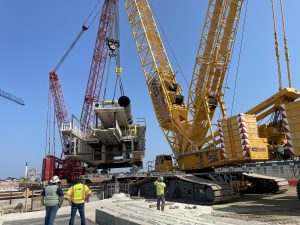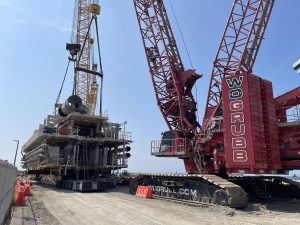W.O. Grubb Handles Heavy Lifts on Virginia’s Largest Highway Project
March 14, 2025
Crane Hotline-March Issue – Cranes in Motion by Seth Skydel – Hampton Roads Bridge-Tunnel
It is the largest highway construction project in Virginia’s history. Starting in 2020 and expected to last until at least the fall of 2026, the $3.9 billion Hampton Roads Bridge-Tunnel (HRBT) expansion aims to ease congestion along a nearly 10-mile corridor on Interstate 64 by adding twin, two-lane 8,000-foot-long bored tunnels from Hampton to Norfolk, Virginia.
In some ways, this is the tale of two machines, both uniquely designed for their roles in the success of the expansive project. One is a 46-foot-high, 430-foot-long tunnel boring machine (TBM) nicknamed Mary that was manufactured by Herrenknecht of Germany for Hampton Roads Connector Partners (HRCP), the project’s joint construction venture.
The other machine is a Liebherr LR1750/2 lattice boom crawler crane in the W.O. Grubb Crane Rental fleet. The 825-ton capacity crane sports a 450-foot main boom, 344-foot luffing fly-jib, 69-foot assembly jib and a derrick attachment and carries 400 tons of counterweight.
W.O. Grubb is a family-owned, Chesterfield, Virginia-based company that provides bare and operated crane rental services in the Mid-Atlantic region. For the HRBT project, the crane rental operator played a key role in several ways, fielding and operating as many as 22 cranes at any given time.
“The size of this project is massive,” said Brian Thiede, engineering manager at W.O. Grubb. “To facilitate work in several phases, we brought in a number of lattice boom crawlers based in our Richmond, Virginia, yard on a long-term basis. Our branches in Portsmouth and Newport News also provided support daily with other cranes, including using all-terrain models and crawlers on barges for piling and bridge work.”
Following 18 months of construction and shipping, the TBM arrived on the HRBT’s South Island. There, over a three-month period, W.O. Grubb assembled the boring machine that was longer than a football field and as high as a four-story building, placing its components in a 65-foot deep pit.
Central to that effort was W.O. Grubb’s Liebherr LRl750/2 lattice boom crawler. Other cranes in the company’s fleet that were essential included a 716-ton Manitowoc MLC 650 lattice boom crawler with a 341.2- foot main boom. A Grove GMK 6400-1 six-axle all-terrain telescopic boom model with a capacity of 450 tons and 197-foot main boom was also used. W.O. Grubb supplied rigging for the lift as well, including heavy braided steel wire rope, shackles and in-house designed and built custom spreader bars.
At the controls of the Liebherr LR1750/2 throughout the entire process was W.O. Grubb crane operator Brian Showalter. “We brought the crane components in under hurricane conditions because there was a tight schedule to keep,” he related. “The compact dimensions of the crane components and moderate individual weights made it easier to transport the machine to the site.
“With full counterweight on the crane and in the ballast trailer, we lifted pieces of the boring machine that were as heavy as 950,000 pounds,” Showalter continued. “At times, we had to switch the rigging because one end of a component was heavier. We also coordinated lifts with another lattice crawler and used an all-terrain as a tailing crane when large TBM components needed to be switched between horizontal and vertical orientations.”
In April 2023, with the TBM assembled, the machine began boring the new tunnel from the South Island on the Norfolk side of the channel. For the next year it travelled 8,000 feet at a rate of about 50 feet per working day.
Boring down to approximately 50 feet below the current tunnels, the TBM excavates soil with a circular cross-section. The technology is favored over the immersed tube design of existing tunnels because it has fewer environmental impacts and does not disrupt Navy, marine or commercial traffic.
One year later, on an April day in 2024, crews of workers gathered on top of another 65-foot deep pit on the Hampton Roads Bridge-Tunnels North Island. Anticipation built as moisture started seeping through cracks in the pit’s concrete wall, then water poured through and a three-story tall circular section of concrete fell, followed by the TBM named Mary.
However, that is hardly the end of the story. In fact, it’s only the halfway mark. What followed over the next few months was, what’s been described as the “world’s longest three-point turn.”
Soon after the TBM saw fresh air for the first time in a year, W.O. Grubb and the Liebherr LR1750/2 were back at, work. This time, after relocating to the north side of the channel, the lattice boom crawler was put to work lifting pieces, turning them and placing them back in the pit for assembly.
During the TBM turnaround process, Showalter also had to lift heavy pieces onto a Goldhofer modular platform trailer in a staging area, then walk the crane away from the pit after each of the lifts to allow the Goldhofer to turn the back up cars 180 degrees. After the pieces were turned, they were ready to be lifted down into the pit facing the opposite direction. Today, the TBM continues the journey back to the Norfolk side.
“I’ve been operating the LRl750/2 since I started working at W.O. Grubb in 2016,” Showalter said. “This job would not have been possible without it.”
“The planning for this project began more than a year before any lifts took place,” Brian Thiede said. “One of the biggest challenges was working on islands where space is limited, not just for the work the cranes needed to do but also during their assembly and disassembly, including the logistics of bringing in components.”
“But there was really no question which crane would be able to handle the work,” Thiede added. “The Liebherr LRl750/2 was the right machine for helping make sure the Hampton Roads Bridge-Tunnel is able to double its capacity once the bridge and road work are done.”
https://secure.viewer.zmags.com/publication/4f26aae8#/4f26aae8/11













